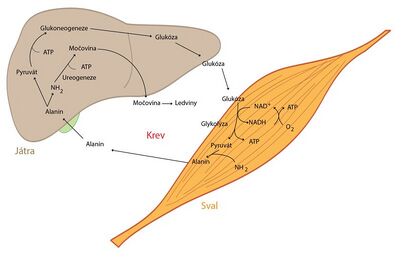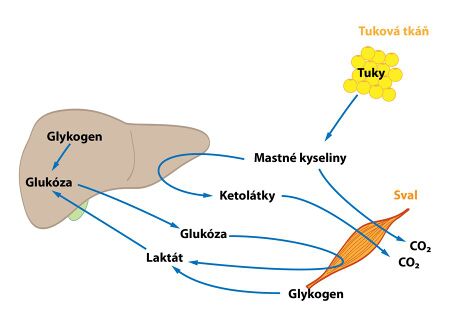Position of organs in energy metabolism
From WikiLectures
Liver[edit | edit source]
- Liver cells (hepatocytes) have a fundamental role in maintaining homeostasis, in the synthesis of molecules, in the mutual conversion of nutrients and in the regulation of energy storage and release. It participates in the metabolism of all nutrients.
Carbohydrate Metabolism[edit | edit source]
- In the metabolism of carbohydrates, their short-term , in the range of hours, and long-term , in the range of days to weeks, regulation of glycemia - glucostatic function of the liver is important. With a high level of glucose in the vena portae after a meal, glycogen synthesis is started in the liver , which consumes the glucose taken from the blood. On the contrary, during fasting and a drop in blood glucose levels, glucose is added to the circulation through glycogenolysis – the breakdown of stored glycogen, or, when glycogen stores are depleted, gluconeogenesis .
Degradation of fructose and galactose also takes place in the liver.
Lipid metabolism[edit | edit source]
- Some pathways of lipid metabolism are unique to the liver - the synthesis of ketone bodies. Most of the pathways also occur elsewhere, but they are quantitatively most significant in the liver. Oxidation of fatty acids takes place here . During starvation, this pathway runs to a greater extent than the liver needs to produce energy for its own consumption. From the resulting acetyl-CoA , ketone bodies are subsequently formed, which the liver cannot process on its own, so they release them into the circulation, where they serve as an alternative source of energy. Cholesterol synthesis also takes place in the liver.
- The position of the liver in lipoprotein metabolism is also key :
- They synthesize VLDL, part of HDL;
- they convert IDL to LDL;
- they degrade chylomicron remnants, HDL and part of LDL.
Protein and amino acid metabolism[edit | edit source]
- In the metabolism of proteins and amino acids, some reactions are again specific for the liver – urea synthesis . Other reactions, for example the deamination and transamination of amino acids or the synthesis of non-essential amino acids, also take place in other organs. The liver also synthesizes (except immunoglobulins) all plasma proteins, eg albumin or coagulation factors.
See Amino Acid Metabolism for more detailed information .
Kidney[edit | edit source]
- Concentrating urine and transporting substances in the kidneys requires a large amount of energy, so the consumption of ATP , especially in the cortex, is high.
- ATP is obtained through the oxidative metabolism of glucose, lactate, fatty acids and amino acids.
- From metabolic pathways, gluconeogenesis also takes place here , especially during starvation. Its main substrate is the carbon skeleton of amino acids - mainly glutamine. Ammonia obtained during the reactions is excreted directly into the urine, where it serves as a buffer .
Skeletal muscles[edit | edit source]
- Skeletal muscles use a large amounts of energy during their activity. ATP regeneration takes place via aerobic and anaerobic glycolysis , fatty acid degradation and also from creatine phosphate .
- The role of skeletal muscle in the metabolism of amino acids , mainly branched (valine, leucine and isoleucine), is essential. Their carbon skeletons are used to generate energy, and their amino groups are used for the synthesis of alanine, glutamine and glutamate, which skeletal muscle releases in large quantities into the circulation. The liver can then regenerate glucose from alanine - the so-called alanine cycle.
See the Glucose-Alanine Cycle page for more detailed information .
Adipose tissue[edit | edit source]
- Adipose tissue is used postprandially - i.e. after a meal, when the influence of insulin prevails , as a storehouse of triacylglycerols . It stores both dietary lipids and those created by the liver. During fasting, when the effect of glucagon prevails , on the contrary, lipolysis occurs - the release of free fatty acids and glycerol.
Brain[edit | edit source]
- Glucose is the main energy substrate of the brain, the daily consumption is 120 g. During adapted starvation , which occurs after approximately 3 weeks without an adequate energy supply, the brain can cover up to 50% of the energy consumption by oxidizing ketone bodies .




